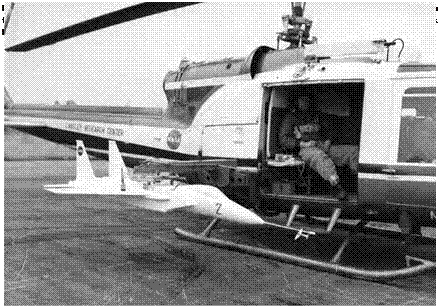New Levels of Departure Resistance: The F-15 Program
![]() After its traumatic experiences with the F-4 stability and control deficiencies at high angles of attack, the Air Force encouraged competitors in the F-15 selection process to stress good high-angle-of-attack characteristics for the candidate configurations of their proposed aircraft. As part of the source selection process, an analysis of departure resistance was required based on high Reynolds number aerodynamic data obtained for each design in the NASA Ames 12-Foot Pressure Tunnel. In addition, spin and recovery characteristics were determined during the competitive phase using models in the Langley Spin Tunnel. The source selection team evaluated data from these and other high-angle – of-attack tests and analysis.
After its traumatic experiences with the F-4 stability and control deficiencies at high angles of attack, the Air Force encouraged competitors in the F-15 selection process to stress good high-angle-of-attack characteristics for the candidate configurations of their proposed aircraft. As part of the source selection process, an analysis of departure resistance was required based on high Reynolds number aerodynamic data obtained for each design in the NASA Ames 12-Foot Pressure Tunnel. In addition, spin and recovery characteristics were determined during the competitive phase using models in the Langley Spin Tunnel. The source selection team evaluated data from these and other high-angle – of-attack tests and analysis.
In its role as an air superiority fighter, the winning McDonnell – Douglas F-15 design was carefully crafted to exhibit superior stability and departure resistance at high angles of attack. In addition to providing a high level of inherent aerodynamic stability, the McDonnell – Douglas design team devised an automatic control concept to avoid control-induced departures at high angles of attack because of adverse yaw from lateral control (ailerons and differential horizontal tail deflections). By using an automatic aileron washout scheme that reduced the amount of aileron/tail deflections obtainable at high angles of attack and an interconnect system that deflected the rudder for roll control as a
 |
|
function of angle of attack within its Command Augmentation System (CAS), the F-15 was expected to exhibit exceptional stability and departure resistance at high angles of attack.
NASA’s free-flight model tests of the F-15 in the Langley Full-Scale Tunnel during 1971 verified that the F-15 would be very stable at high – angle-of-attack conditions, in dramatic contrast to its immediate predecessors.[1295] During the F-15 development process, spin tunnel testing at Langley provided predictions for spin modes for the basic airplane as well as an extensive number of external stores, and an emergency spin recovery parachute size was determined.
Langley was also requested to evaluate the spin resistance of the F-15 with the outdoor helicopter drop-model technique used at Langley for many previous assessments of spin resistance. During spin entry attempts of the drop model with the CAS operative, it was once again obvious that the configuration was very spin resistant. In fact, an exceptional effort was required by the Langley team to develop a longitudinal
and lateral-directional control input technique to spin the model. Ultimately, such a technique was identified and demonstrated, although it was successful for a very constrained range of flight variables. This spin entry technique was later used in the full-scale aircraft flight program to promote spins. In 1972, Dryden constructed a larger drop model with a more complete representation of the aircraft flight control system and a larger-scale prediction of the airplanes spin recovery characteristics. Launched from a B-52 and known as the F-15 spin research vehicle (SRV), the remotely piloted vehicle verified the predictions of the smaller model and added confidence to the subsequent flight tests.[1296]
![]() Meanwhile, testing in the Spin Tunnel concentrated on one of the more critical spin conditions for the F-15 aircraft—unsymmetrical mass loadings. Model tests showed that the configuration’s spin and recovery characteristics deteriorated when lateral unbalance was simulated, as would be the situation for asymmetric weapon store loadings on the right and left wing panels or fuel imbalance between wing tanks. Fuel imbalance can occur during banked turns in strenuous air combat maneuvers when tanks feed at different rates. The results of the spin tunnel tests showed that the spins would be faster and flatter in one direction, and that recovery would not be possible when the mass imbalance exceeded a certain critical value. As frequently happens in the field of spinning and spin recovery, a configuration that was extremely spin resistant in the "clean” configuration suddenly became an unmanageable tiger with mass imbalance.
Meanwhile, testing in the Spin Tunnel concentrated on one of the more critical spin conditions for the F-15 aircraft—unsymmetrical mass loadings. Model tests showed that the configuration’s spin and recovery characteristics deteriorated when lateral unbalance was simulated, as would be the situation for asymmetric weapon store loadings on the right and left wing panels or fuel imbalance between wing tanks. Fuel imbalance can occur during banked turns in strenuous air combat maneuvers when tanks feed at different rates. The results of the spin tunnel tests showed that the spins would be faster and flatter in one direction, and that recovery would not be possible when the mass imbalance exceeded a certain critical value. As frequently happens in the field of spinning and spin recovery, a configuration that was extremely spin resistant in the "clean” configuration suddenly became an unmanageable tiger with mass imbalance.
During its operational service, the F-15 has experienced several accidents caused by unrecoverable spins with asymmetric loadings. At one time, this type of accident was the second greatest cause of F-15 losses, after midair collisions.[1297]
Comparison of theoretical predictions, spin tunnel results, drop-model results, and flight results indicated that correlation of a model and airplane results were very good and that risk in the full-scale program had been reduced considerably by the NASA model tests.










